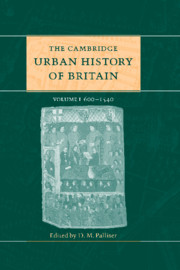24 - Conclusion
from Part V - Conclusion
Published online by Cambridge University Press: 28 March 2008
Summary
We have in this volume surveyed the towns of three countries over a span of nine centuries. The reader who has followed our contributions so far, or is about to engage with the urbanisation charted by Peter Clark and his colleagues in Volume II, may well expect some broad insights underlying our detailed analyses. What are the most significant of them?
First, towns before the sixteenth century were collectively more important, populous and wealthy than is still often acknowledged by historians of later periods. After the earliest period of intermittent urbanisation (or reurbanisation) in England between c. 600 and 850, there followed what Christopher Dyer has characterised as ‘a period of sustained urban growth’ between c. 880 and 1080. This is a claim fully confirmed by the studies in Part II of this volume, and should not unduly surprise us, for the growth of towns was only one of a series of important economic developments in late Anglo-Saxon England, changes which were perhaps ‘more significant than any which took place in the sixteenth century or even later’. Dyer's ‘second period of urbanization’, this time involving Britain as a whole, lies between the late eleventh and early fourteenth centuries, and is much better known. Richard Britnell suggests that for England, where the statistics are best, towns may have accounted for almost 10 per cent of the national population by 1086 and up to 15 per cent by about 1300; Dyer would go further and see a doubling of the proportion living in towns.
- Type
- Chapter
- Information
- The Cambridge Urban History of Britain , pp. 739 - 746Publisher: Cambridge University PressPrint publication year: 2000



